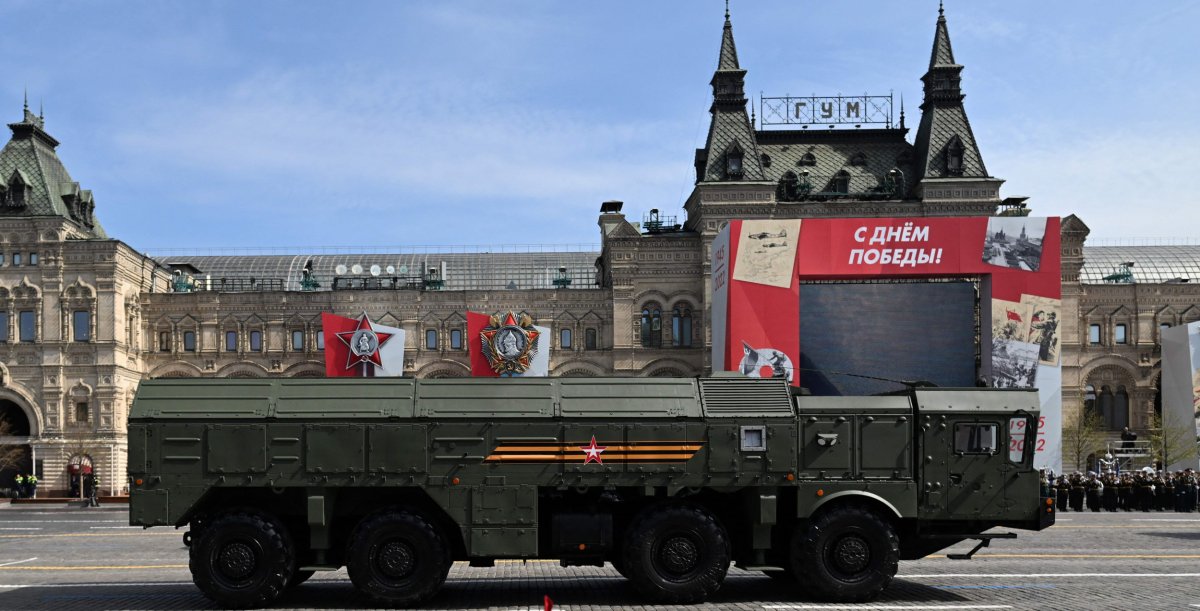Russia has formed an Iskander missile brigade in its region bordering new NATO member Finland, while another alliance member, Poland, warned of the nuclear-weapons risk that Moscow poses.
The Iskander-M ballistic missiles can fire conventional as well as nuclear warheads. Kremlin-friendly newspaper Izvestia reported that the system is key to the presence in Russia's Karelia Republic of the Leningrad Military District (LMD), which was formed after Helsinki joined the alliance last April.
Meanwhile, Poland's President Andrzej Duda said in an interview released Monday that Warsaw is willing to allow NATO allies to deploy nuclear weapons on its territory, in light of the nuclear threat that Moscow presents to the alliance.
Russian Ministry of Defense sources told Izvestia that a separate missile brigade had been formed equipped with the Iskander systems, which were likely part of a corps within the LMD.
Newsweek has emailed the Russian Defense Ministry for comment.

K720 Iskander-M's Capabilities
The 9K720 Iskander-M, which has the NATO reporting name SS-26 Stone, is a mobile short-range ballistic missile system at the heart of Russia's modern precision strike capability.
First developed in the 1970s to replace the Scud-B, the program was accelerated to replace the SS-23 Spider, which Moscow retired in 1988 because of restrictions mandated by the INF (Intermediate-Range Nuclear Forces Treaty.)
Brought into operation in 2006, the Iskander can carry conventional and nuclear warheads weighing up to 1,500 pounds. Its missiles can travel at up to seven times the speed of sound (Mach 7) and can reach an altitude of more than 30 miles.
The system employs a maneuverable reentry vehicle (MaRV) and decoys to defeat theater missile defense systems, according to the Missile Defense Advocacy Alliance (MDAA).
First combat-tested in 2008 during the Russo-Georgian War, the Iskander can use include conventional warheads such as cluster warheads, fuel-air explosives, bunker-busters, and electromagnetic pulse (EMP) warheads.
The MDAA described the Iskander as "the weapon of choice for Moscow when making threats throughout Europe," adding how, in 2012, Moscow said it could be used to target missile defense systems in Europe, including a threat to deploy some of the missiles to the Russian enclave of Kaliningrad bordering the Baltic states.
The Royal United Services Institute (RUSI) said in an assessment in August 2022 that Iskanders provided "a significant capability" for Russia's military and had been used in tactical-operation strikes in its full-scale invasion of Ukraine.
"Furthermore, their role in supporting Russia's non-strategic nuclear arsenal means that they are not only a war-shaping capability, but also potentially critical to strategies for war termination," the London thinktank said.
Iskanders are assigned to Russia's Missile Brigades, which are separate from the Strategic Missile Brigades that employ the country's ground-based strategic missiles, RUSI said. These support ground troops with operational-tactical precision strikes and least one brigade is assigned to each of Russia's military districts.
The Iskander system is likely to be key to Moscow's attempt to manage escalation "through either targeting of critical infrastructure across Europe with conventional precision strikes or the threat of nonstrategic nuclear weapons use," it added.
Leaked military documents reported by the U.K. newspaper Financial Times in February describe how Moscow's threshold for tactical nuclear weapons use was "lower than Russia has ever publicly admitted," according to experts.
Within the context of a Russian nuclear threat, Duda told the Polish daily newspaper Fakt that discussions with the U.S. about placing nuclear weapons in Poland had been ongoing for a while.
"If our allies decide to deploy nuclear weapons as part of nuclear sharing also on our territory to strengthen the security of NATO's eastern flank, we are ready for it," Duda said.
Uncommon Knowledge
Newsweek is committed to challenging conventional wisdom and finding connections in the search for common ground.
Newsweek is committed to challenging conventional wisdom and finding connections in the search for common ground.
About the writer
Brendan Cole is a Newsweek Senior News Reporter based in London, UK. His focus is Russia and Ukraine, in particular ... Read more
To read how Newsweek uses AI as a newsroom tool, Click here.






